CHM101 La Trobe Chemistry Practical: Red Cabbage Indicator and pH
VerifiedAdded on 2023/06/15
|8
|1331
|66
Practical Assignment
AI Summary
This practical assignment focuses on extracting a universal indicator from red cabbage and using it to determine the pH of various household substances. The experiment involves observing color changes in different solutions (lemon juice, tap water, egg white, etc.) after adding the red cabbage indicator. The results are then used to estimate the pH of each substance. The assignment also includes questions about acidity, alkalinity, chemical reactions, and equilibrium constants related to acids and bases, specifically addressing the behavior of acetic acid and sodium bicarbonate. The student uses experimental observations and chemical principles to explain the properties of acids, bases, and indicators. Find more solved assignments on Desklib.
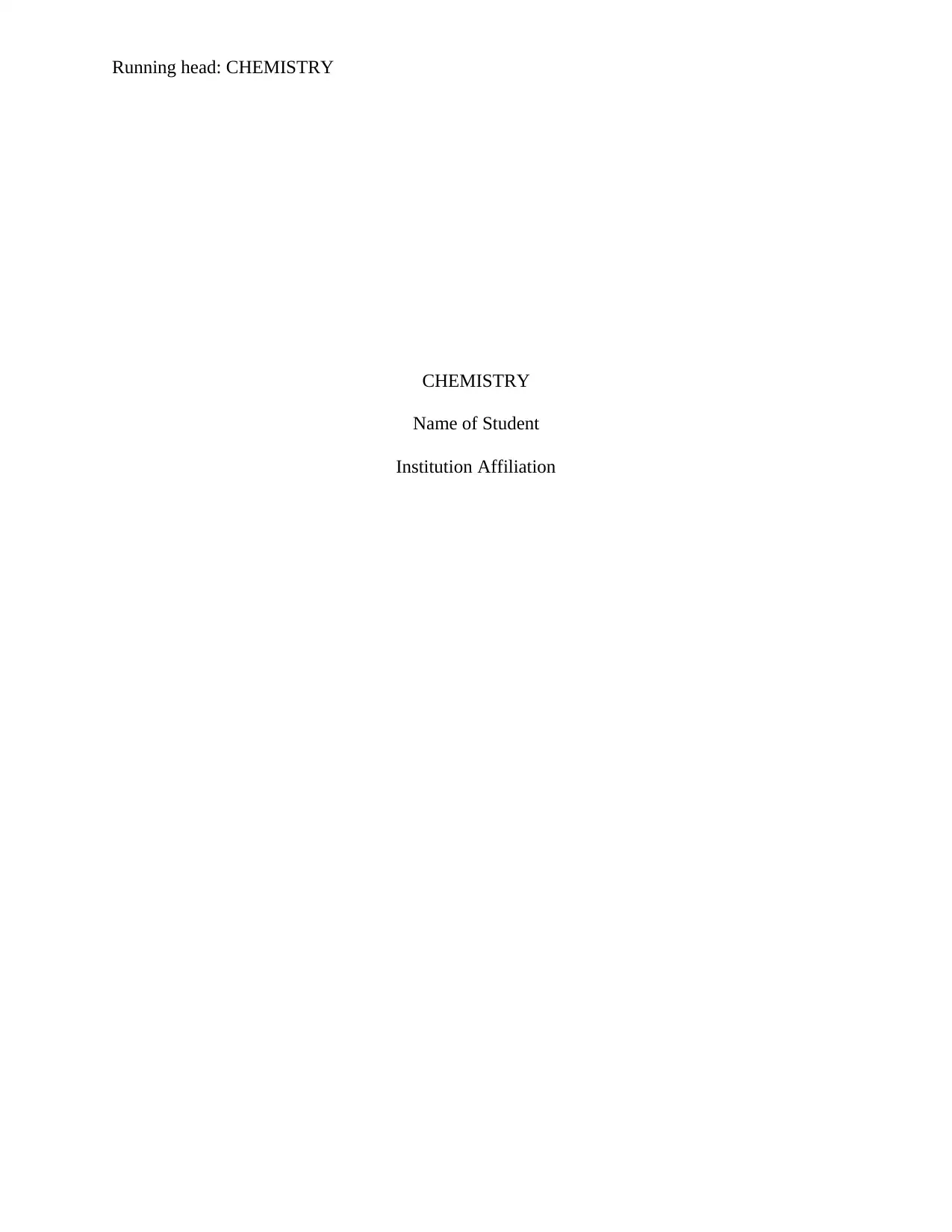
Running head: CHEMISTRY
CHEMISTRY
Name of Student
Institution Affiliation
CHEMISTRY
Name of Student
Institution Affiliation
Paraphrase This Document
Need a fresh take? Get an instant paraphrase of this document with our AI Paraphraser
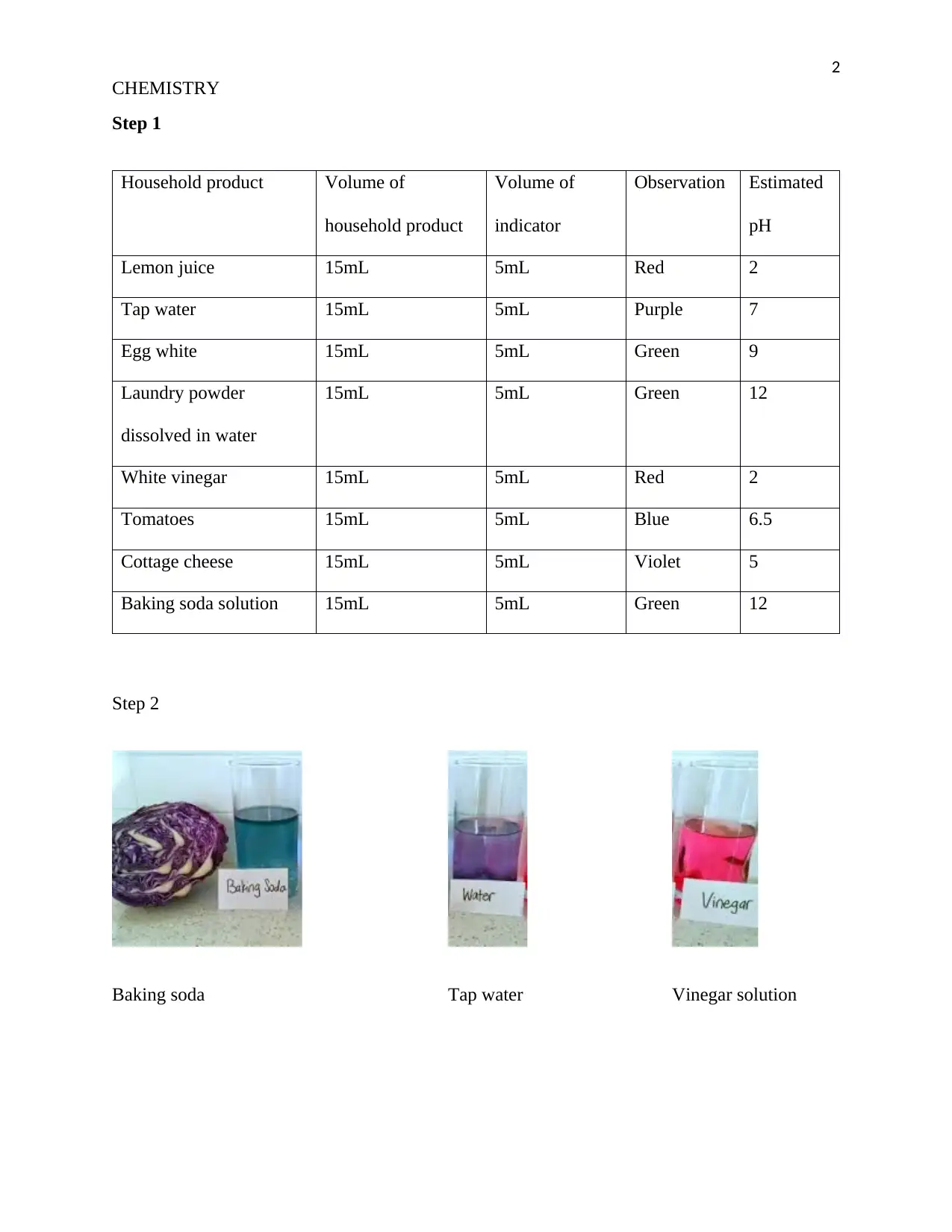
2
CHEMISTRY
Step 1
Household product Volume of
household product
Volume of
indicator
Observation Estimated
pH
Lemon juice 15mL 5mL Red 2
Tap water 15mL 5mL Purple 7
Egg white 15mL 5mL Green 9
Laundry powder
dissolved in water
15mL 5mL Green 12
White vinegar 15mL 5mL Red 2
Tomatoes 15mL 5mL Blue 6.5
Cottage cheese 15mL 5mL Violet 5
Baking soda solution 15mL 5mL Green 12
Step 2
Baking soda Tap water Vinegar solution
CHEMISTRY
Step 1
Household product Volume of
household product
Volume of
indicator
Observation Estimated
pH
Lemon juice 15mL 5mL Red 2
Tap water 15mL 5mL Purple 7
Egg white 15mL 5mL Green 9
Laundry powder
dissolved in water
15mL 5mL Green 12
White vinegar 15mL 5mL Red 2
Tomatoes 15mL 5mL Blue 6.5
Cottage cheese 15mL 5mL Violet 5
Baking soda solution 15mL 5mL Green 12
Step 2
Baking soda Tap water Vinegar solution
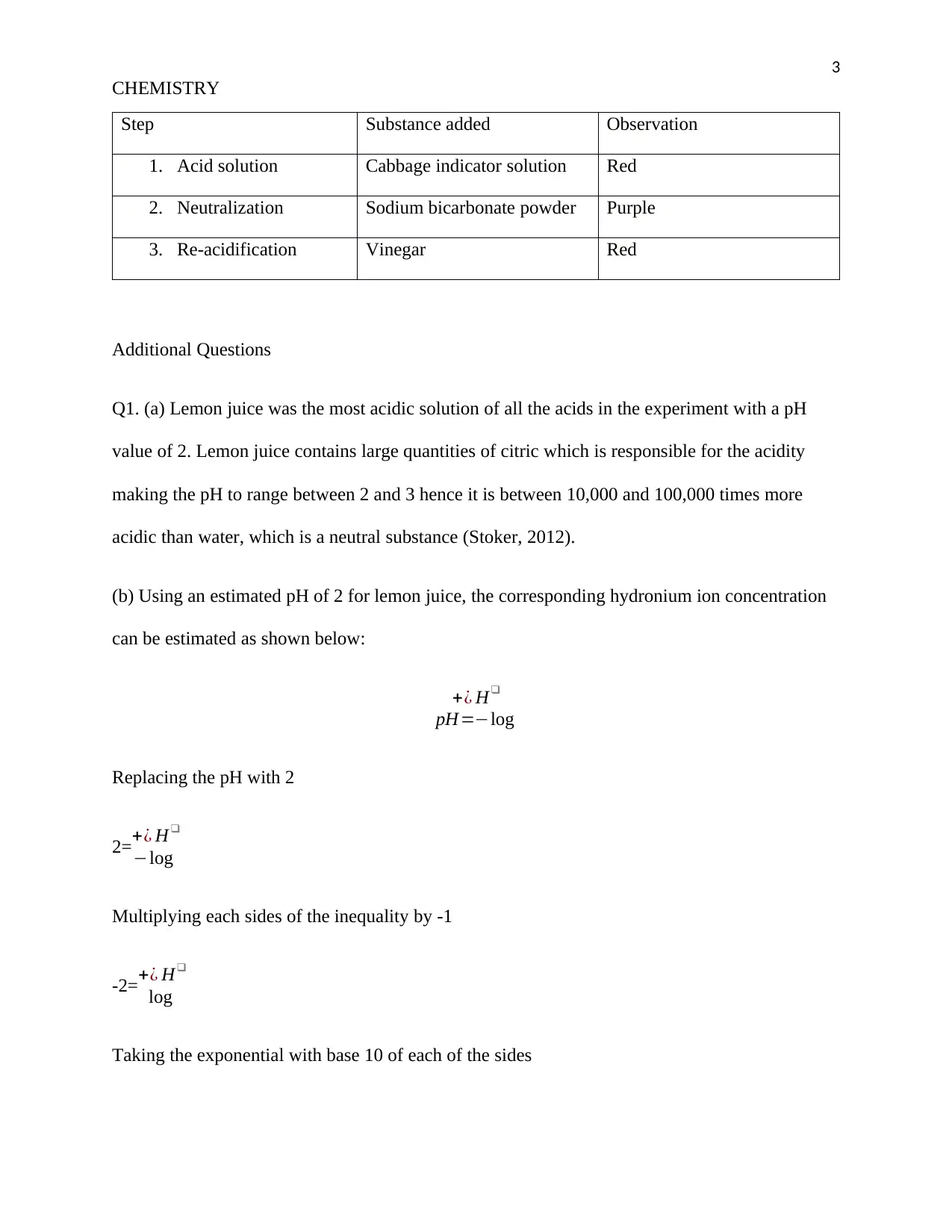
3
CHEMISTRY
Step Substance added Observation
1. Acid solution Cabbage indicator solution Red
2. Neutralization Sodium bicarbonate powder Purple
3. Re-acidification Vinegar Red
Additional Questions
Q1. (a) Lemon juice was the most acidic solution of all the acids in the experiment with a pH
value of 2. Lemon juice contains large quantities of citric which is responsible for the acidity
making the pH to range between 2 and 3 hence it is between 10,000 and 100,000 times more
acidic than water, which is a neutral substance (Stoker, 2012).
(b) Using an estimated pH of 2 for lemon juice, the corresponding hydronium ion concentration
can be estimated as shown below:
+¿ H❑
pH =−log
Replacing the pH with 2
2=+¿ H❑
−log
Multiplying each sides of the inequality by -1
-2=+¿ H❑
log
Taking the exponential with base 10 of each of the sides
CHEMISTRY
Step Substance added Observation
1. Acid solution Cabbage indicator solution Red
2. Neutralization Sodium bicarbonate powder Purple
3. Re-acidification Vinegar Red
Additional Questions
Q1. (a) Lemon juice was the most acidic solution of all the acids in the experiment with a pH
value of 2. Lemon juice contains large quantities of citric which is responsible for the acidity
making the pH to range between 2 and 3 hence it is between 10,000 and 100,000 times more
acidic than water, which is a neutral substance (Stoker, 2012).
(b) Using an estimated pH of 2 for lemon juice, the corresponding hydronium ion concentration
can be estimated as shown below:
+¿ H❑
pH =−log
Replacing the pH with 2
2=+¿ H❑
−log
Multiplying each sides of the inequality by -1
-2=+¿ H❑
log
Taking the exponential with base 10 of each of the sides
⊘ This is a preview!⊘
Do you want full access?
Subscribe today to unlock all pages.

Trusted by 1+ million students worldwide
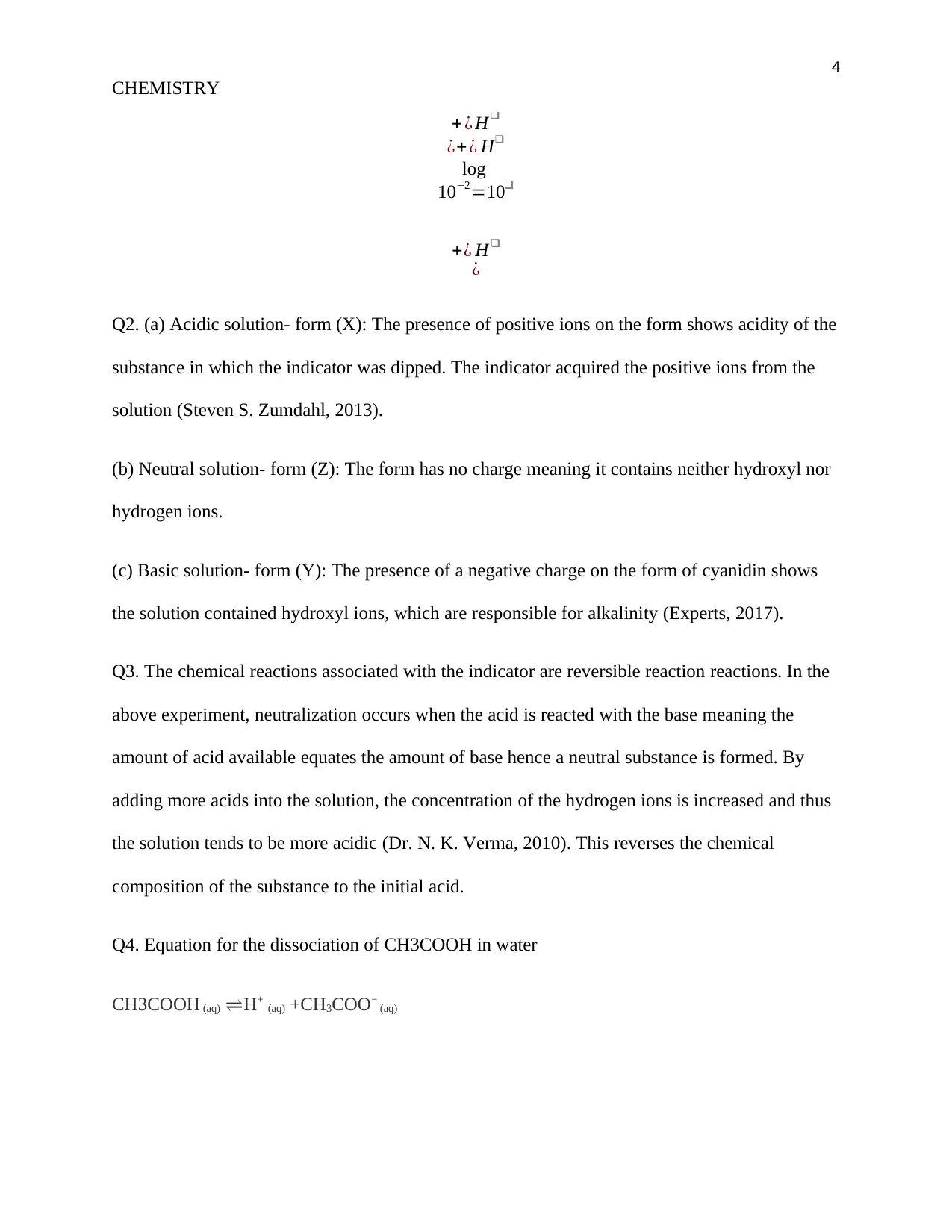
4
CHEMISTRY
+ ¿ H❑
¿+¿ H❑
log
10−2 =10❑
+¿ H❑
¿
Q2. (a) Acidic solution- form (X): The presence of positive ions on the form shows acidity of the
substance in which the indicator was dipped. The indicator acquired the positive ions from the
solution (Steven S. Zumdahl, 2013).
(b) Neutral solution- form (Z): The form has no charge meaning it contains neither hydroxyl nor
hydrogen ions.
(c) Basic solution- form (Y): The presence of a negative charge on the form of cyanidin shows
the solution contained hydroxyl ions, which are responsible for alkalinity (Experts, 2017).
Q3. The chemical reactions associated with the indicator are reversible reaction reactions. In the
above experiment, neutralization occurs when the acid is reacted with the base meaning the
amount of acid available equates the amount of base hence a neutral substance is formed. By
adding more acids into the solution, the concentration of the hydrogen ions is increased and thus
the solution tends to be more acidic (Dr. N. K. Verma, 2010). This reverses the chemical
composition of the substance to the initial acid.
Q4. Equation for the dissociation of CH3COOH in water
CH3COOH (aq) ⇌H+ (aq) +CH3COO− (aq)
CHEMISTRY
+ ¿ H❑
¿+¿ H❑
log
10−2 =10❑
+¿ H❑
¿
Q2. (a) Acidic solution- form (X): The presence of positive ions on the form shows acidity of the
substance in which the indicator was dipped. The indicator acquired the positive ions from the
solution (Steven S. Zumdahl, 2013).
(b) Neutral solution- form (Z): The form has no charge meaning it contains neither hydroxyl nor
hydrogen ions.
(c) Basic solution- form (Y): The presence of a negative charge on the form of cyanidin shows
the solution contained hydroxyl ions, which are responsible for alkalinity (Experts, 2017).
Q3. The chemical reactions associated with the indicator are reversible reaction reactions. In the
above experiment, neutralization occurs when the acid is reacted with the base meaning the
amount of acid available equates the amount of base hence a neutral substance is formed. By
adding more acids into the solution, the concentration of the hydrogen ions is increased and thus
the solution tends to be more acidic (Dr. N. K. Verma, 2010). This reverses the chemical
composition of the substance to the initial acid.
Q4. Equation for the dissociation of CH3COOH in water
CH3COOH (aq) ⇌H+ (aq) +CH3COO− (aq)
Paraphrase This Document
Need a fresh take? Get an instant paraphrase of this document with our AI Paraphraser
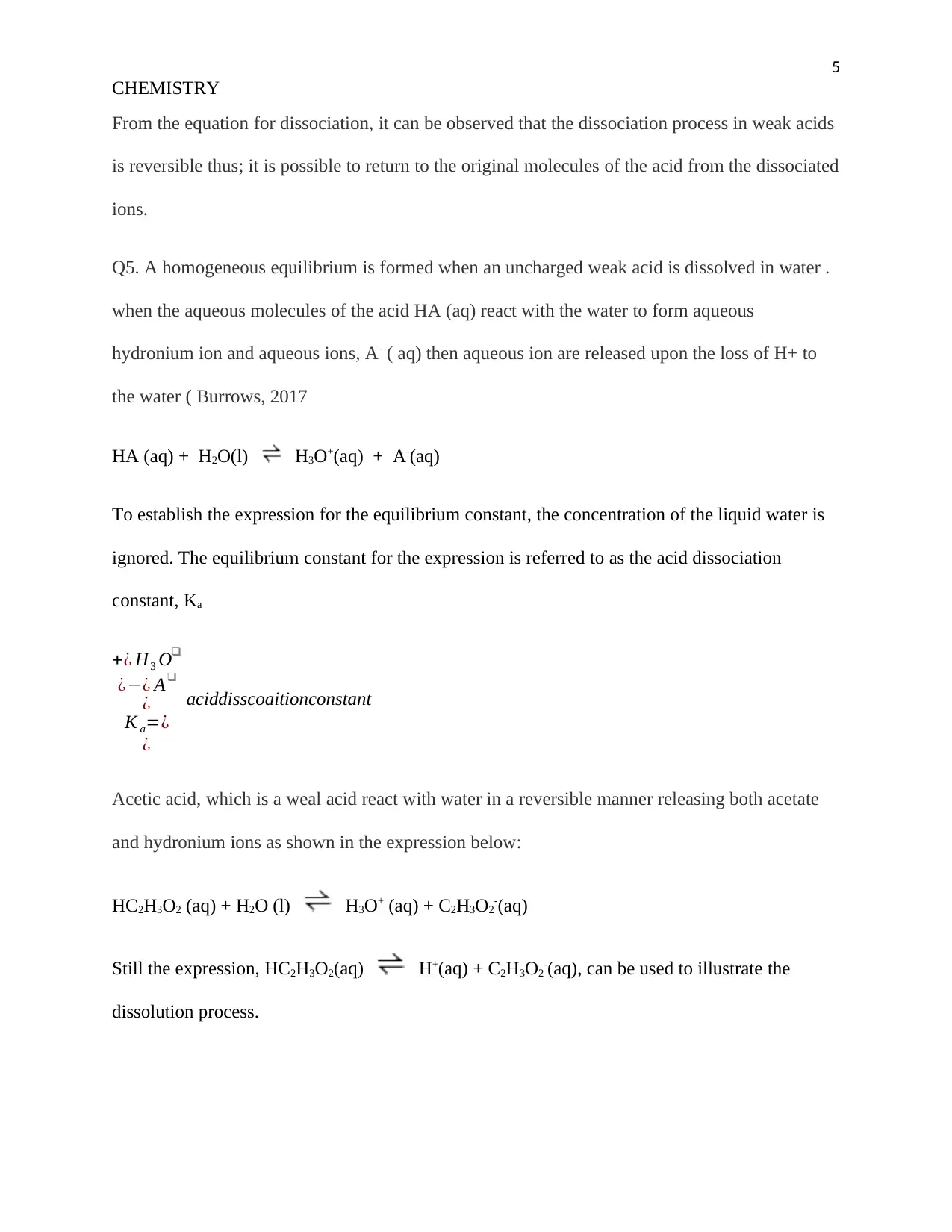
5
CHEMISTRY
From the equation for dissociation, it can be observed that the dissociation process in weak acids
is reversible thus; it is possible to return to the original molecules of the acid from the dissociated
ions.
Q5. A homogeneous equilibrium is formed when an uncharged weak acid is dissolved in water .
when the aqueous molecules of the acid HA (aq) react with the water to form aqueous
hydronium ion and aqueous ions, A- ( aq) then aqueous ion are released upon the loss of H+ to
the water ( Burrows, 2017
HA (aq) + H2O(l) H3O+(aq) + A-(aq)
To establish the expression for the equilibrium constant, the concentration of the liquid water is
ignored. The equilibrium constant for the expression is referred to as the acid dissociation
constant, Ka
+¿ H3 O❑
¿−¿ A❑
¿
K a=¿
¿
aciddisscoaitionconstant
Acetic acid, which is a weal acid react with water in a reversible manner releasing both acetate
and hydronium ions as shown in the expression below:
HC2H3O2 (aq) + H2O (l) H3O+ (aq) + C2H3O2-(aq)
Still the expression, HC2H3O2(aq) H+(aq) + C2H3O2-(aq), can be used to illustrate the
dissolution process.
CHEMISTRY
From the equation for dissociation, it can be observed that the dissociation process in weak acids
is reversible thus; it is possible to return to the original molecules of the acid from the dissociated
ions.
Q5. A homogeneous equilibrium is formed when an uncharged weak acid is dissolved in water .
when the aqueous molecules of the acid HA (aq) react with the water to form aqueous
hydronium ion and aqueous ions, A- ( aq) then aqueous ion are released upon the loss of H+ to
the water ( Burrows, 2017
HA (aq) + H2O(l) H3O+(aq) + A-(aq)
To establish the expression for the equilibrium constant, the concentration of the liquid water is
ignored. The equilibrium constant for the expression is referred to as the acid dissociation
constant, Ka
+¿ H3 O❑
¿−¿ A❑
¿
K a=¿
¿
aciddisscoaitionconstant
Acetic acid, which is a weal acid react with water in a reversible manner releasing both acetate
and hydronium ions as shown in the expression below:
HC2H3O2 (aq) + H2O (l) H3O+ (aq) + C2H3O2-(aq)
Still the expression, HC2H3O2(aq) H+(aq) + C2H3O2-(aq), can be used to illustrate the
dissolution process.
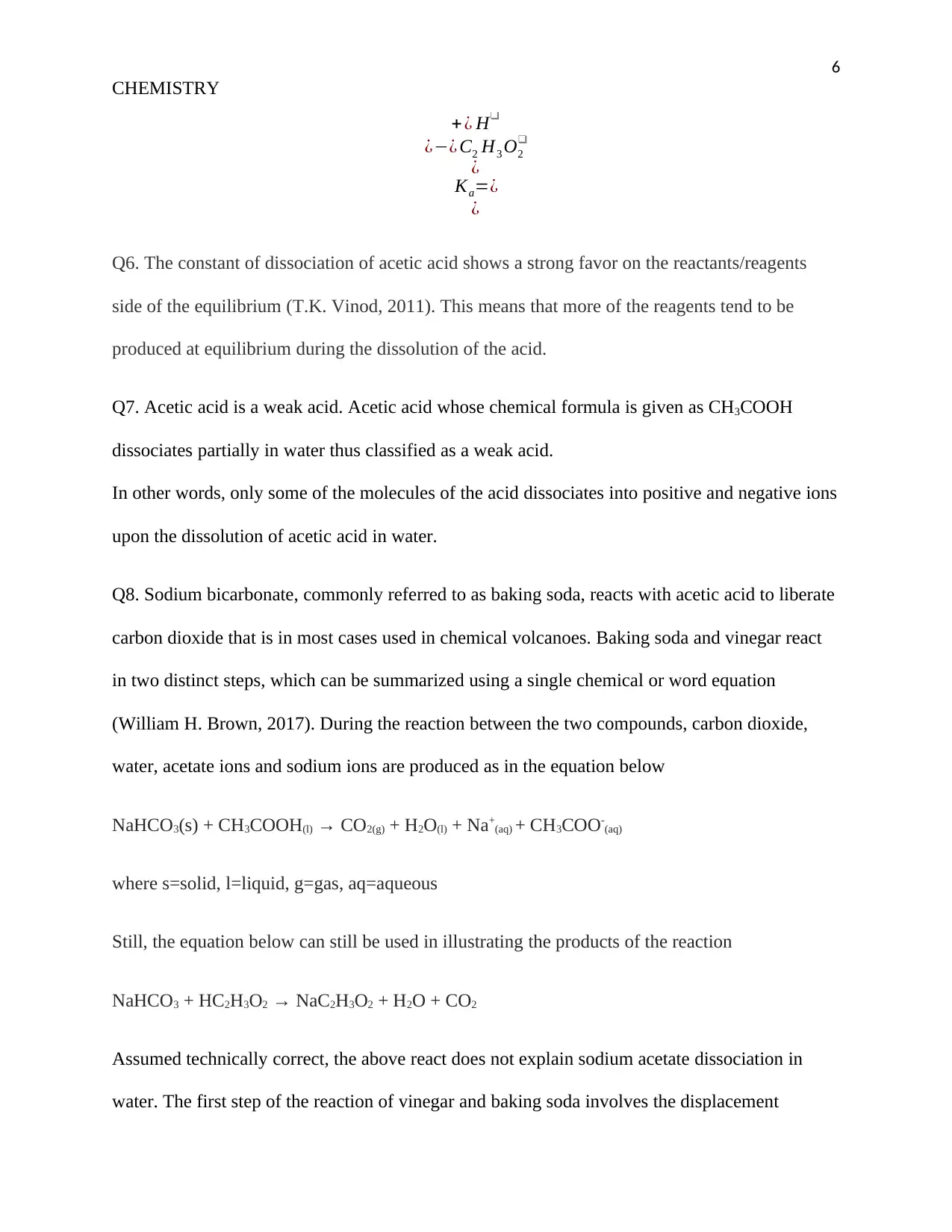
6
CHEMISTRY
+ ¿ H❑
¿−¿ C2 H3 O2
❑
¿
Ka=¿
¿
Q6. The constant of dissociation of acetic acid shows a strong favor on the reactants/reagents
side of the equilibrium (T.K. Vinod, 2011). This means that more of the reagents tend to be
produced at equilibrium during the dissolution of the acid.
Q7. Acetic acid is a weak acid. Acetic acid whose chemical formula is given as CH3COOH
dissociates partially in water thus classified as a weak acid.
In other words, only some of the molecules of the acid dissociates into positive and negative ions
upon the dissolution of acetic acid in water.
Q8. Sodium bicarbonate, commonly referred to as baking soda, reacts with acetic acid to liberate
carbon dioxide that is in most cases used in chemical volcanoes. Baking soda and vinegar react
in two distinct steps, which can be summarized using a single chemical or word equation
(William H. Brown, 2017). During the reaction between the two compounds, carbon dioxide,
water, acetate ions and sodium ions are produced as in the equation below
NaHCO3(s) + CH3COOH(l) → CO2(g) + H2O(l) + Na+(aq) + CH3COO-(aq)
where s=solid, l=liquid, g=gas, aq=aqueous
Still, the equation below can still be used in illustrating the products of the reaction
NaHCO3 + HC2H3O2 → NaC2H3O2 + H2O + CO2
Assumed technically correct, the above react does not explain sodium acetate dissociation in
water. The first step of the reaction of vinegar and baking soda involves the displacement
CHEMISTRY
+ ¿ H❑
¿−¿ C2 H3 O2
❑
¿
Ka=¿
¿
Q6. The constant of dissociation of acetic acid shows a strong favor on the reactants/reagents
side of the equilibrium (T.K. Vinod, 2011). This means that more of the reagents tend to be
produced at equilibrium during the dissolution of the acid.
Q7. Acetic acid is a weak acid. Acetic acid whose chemical formula is given as CH3COOH
dissociates partially in water thus classified as a weak acid.
In other words, only some of the molecules of the acid dissociates into positive and negative ions
upon the dissolution of acetic acid in water.
Q8. Sodium bicarbonate, commonly referred to as baking soda, reacts with acetic acid to liberate
carbon dioxide that is in most cases used in chemical volcanoes. Baking soda and vinegar react
in two distinct steps, which can be summarized using a single chemical or word equation
(William H. Brown, 2017). During the reaction between the two compounds, carbon dioxide,
water, acetate ions and sodium ions are produced as in the equation below
NaHCO3(s) + CH3COOH(l) → CO2(g) + H2O(l) + Na+(aq) + CH3COO-(aq)
where s=solid, l=liquid, g=gas, aq=aqueous
Still, the equation below can still be used in illustrating the products of the reaction
NaHCO3 + HC2H3O2 → NaC2H3O2 + H2O + CO2
Assumed technically correct, the above react does not explain sodium acetate dissociation in
water. The first step of the reaction of vinegar and baking soda involves the displacement
⊘ This is a preview!⊘
Do you want full access?
Subscribe today to unlock all pages.

Trusted by 1+ million students worldwide
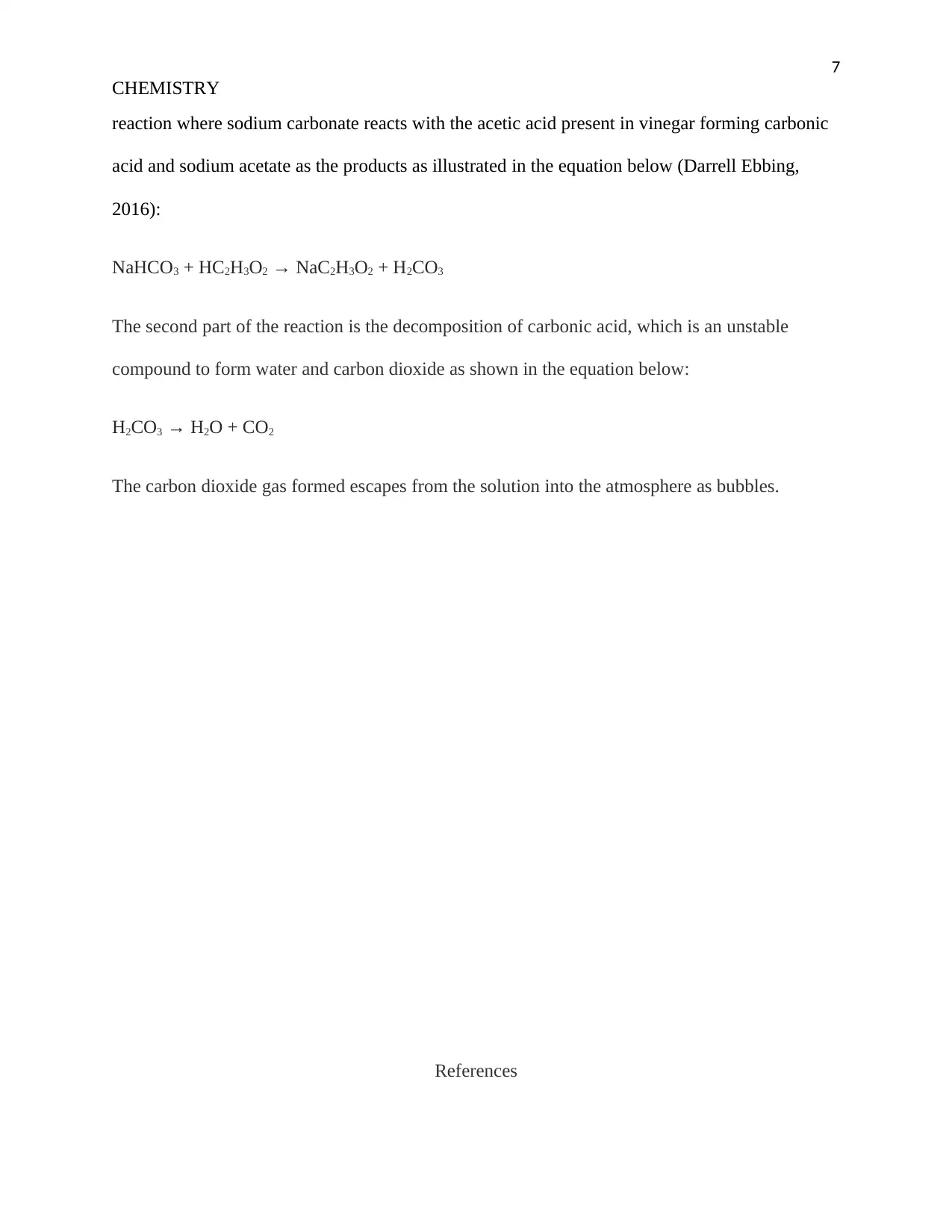
7
CHEMISTRY
reaction where sodium carbonate reacts with the acetic acid present in vinegar forming carbonic
acid and sodium acetate as the products as illustrated in the equation below (Darrell Ebbing,
2016):
NaHCO3 + HC2H3O2 → NaC2H3O2 + H2CO3
The second part of the reaction is the decomposition of carbonic acid, which is an unstable
compound to form water and carbon dioxide as shown in the equation below:
H2CO3 → H2O + CO2
The carbon dioxide gas formed escapes from the solution into the atmosphere as bubbles.
References
CHEMISTRY
reaction where sodium carbonate reacts with the acetic acid present in vinegar forming carbonic
acid and sodium acetate as the products as illustrated in the equation below (Darrell Ebbing,
2016):
NaHCO3 + HC2H3O2 → NaC2H3O2 + H2CO3
The second part of the reaction is the decomposition of carbonic acid, which is an unstable
compound to form water and carbon dioxide as shown in the equation below:
H2CO3 → H2O + CO2
The carbon dioxide gas formed escapes from the solution into the atmosphere as bubbles.
References
Paraphrase This Document
Need a fresh take? Get an instant paraphrase of this document with our AI Paraphraser
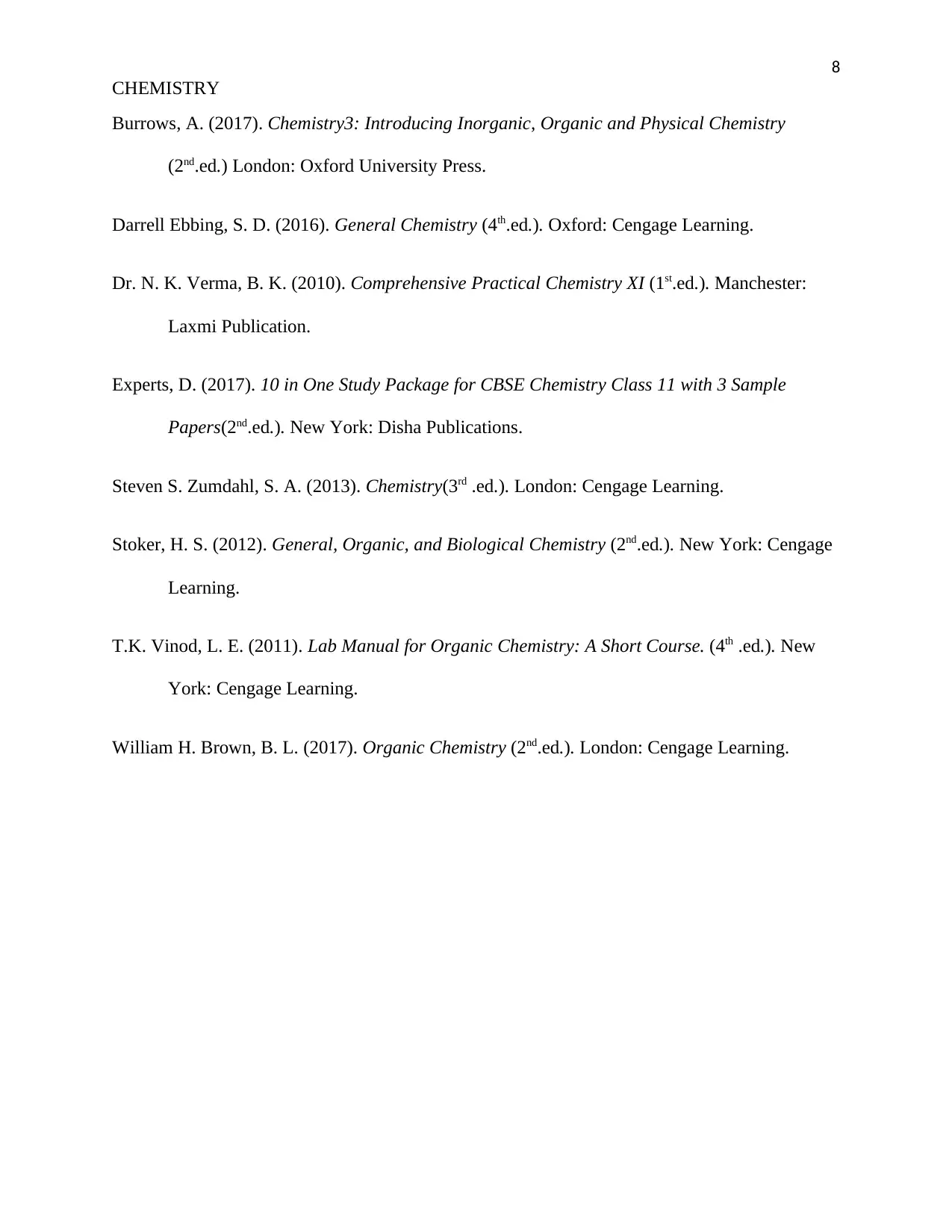
8
CHEMISTRY
Burrows, A. (2017). Chemistry3: Introducing Inorganic, Organic and Physical Chemistry
(2nd.ed.) London: Oxford University Press.
Darrell Ebbing, S. D. (2016). General Chemistry (4th.ed.). Oxford: Cengage Learning.
Dr. N. K. Verma, B. K. (2010). Comprehensive Practical Chemistry XI (1st.ed.). Manchester:
Laxmi Publication.
Experts, D. (2017). 10 in One Study Package for CBSE Chemistry Class 11 with 3 Sample
Papers(2nd.ed.). New York: Disha Publications.
Steven S. Zumdahl, S. A. (2013). Chemistry(3rd .ed.). London: Cengage Learning.
Stoker, H. S. (2012). General, Organic, and Biological Chemistry (2nd.ed.). New York: Cengage
Learning.
T.K. Vinod, L. E. (2011). Lab Manual for Organic Chemistry: A Short Course. (4th .ed.). New
York: Cengage Learning.
William H. Brown, B. L. (2017). Organic Chemistry (2nd.ed.). London: Cengage Learning.
CHEMISTRY
Burrows, A. (2017). Chemistry3: Introducing Inorganic, Organic and Physical Chemistry
(2nd.ed.) London: Oxford University Press.
Darrell Ebbing, S. D. (2016). General Chemistry (4th.ed.). Oxford: Cengage Learning.
Dr. N. K. Verma, B. K. (2010). Comprehensive Practical Chemistry XI (1st.ed.). Manchester:
Laxmi Publication.
Experts, D. (2017). 10 in One Study Package for CBSE Chemistry Class 11 with 3 Sample
Papers(2nd.ed.). New York: Disha Publications.
Steven S. Zumdahl, S. A. (2013). Chemistry(3rd .ed.). London: Cengage Learning.
Stoker, H. S. (2012). General, Organic, and Biological Chemistry (2nd.ed.). New York: Cengage
Learning.
T.K. Vinod, L. E. (2011). Lab Manual for Organic Chemistry: A Short Course. (4th .ed.). New
York: Cengage Learning.
William H. Brown, B. L. (2017). Organic Chemistry (2nd.ed.). London: Cengage Learning.
1 out of 8
Related Documents
Your All-in-One AI-Powered Toolkit for Academic Success.
+13062052269
info@desklib.com
Available 24*7 on WhatsApp / Email
![[object Object]](/_next/static/media/star-bottom.7253800d.svg)
Unlock your academic potential
Copyright © 2020–2025 A2Z Services. All Rights Reserved. Developed and managed by ZUCOL.





